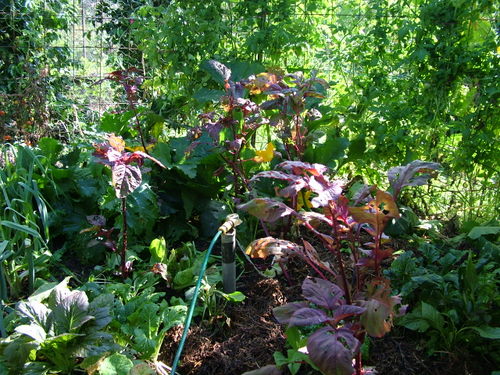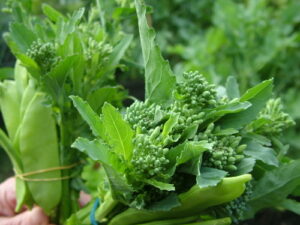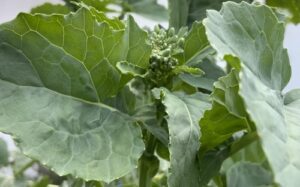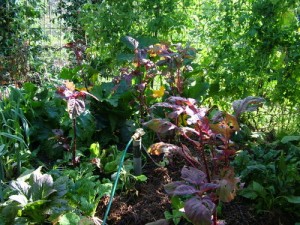Remember the luffa seed I planted last month? It came up (a bit surprisingly – the seed was several years old). So today I planted out three seedlings along the left side fence of this bed, where some tomatoes came out.
 That’s the north-western side, so it will make the bed very shady, but for the next few months, that’s not such a bad thing. The purple king beans on the eastern side will be finished before the luffa take over the fence, and the bed will get some morning light. But in these long hot summer days, almost everything does better for a bit of shade.
That’s the north-western side, so it will make the bed very shady, but for the next few months, that’s not such a bad thing. The purple king beans on the eastern side will be finished before the luffa take over the fence, and the bed will get some morning light. But in these long hot summer days, almost everything does better for a bit of shade.
From late winter until now, I plant climbers – beans, cucumbers, squash and tomatoes – along the fences all the way round from the eastern to the western side, and sometimes (usually a bit more lightly) on the northern side too. The tallest beans even start to climb across the netting over top of my beds, the beans hanging down like fruit.
But from late summer onwards, I start planting climbers only from the south east round to the south west. From the summer solstice onwards, the sun will start dropping lower and lower in the northern sky. People are usually surprised when they actually measure it, how low in the sky the sun is in winter. We think of it like a child’s drawing, with the sun directly above, but that’s only the case for a few hours in the middle of the day in a few weeks in midsummer. In fact climbers on the southern side of a bed won’t shade anything to the north of them all day long, all year long.
Luckily most of the really rampant climbers are summer annuals, and in midsummer, I can let them be rampant climbers. Love those neat fits! In winter I only have to find space for peas and snow peas on the southern fences.
Today I’ve also planted out a new round of tomatoes (all four varieties, but only a four or five plants of each. I have learned my lesson! If I fill up every good tomato spot with tomatoes this year, next year I will have to either go without tomatoes, or plant again in places they’ve been recently, which will lead to soil bourne bacterial and virus diseases.) I’ll put in another round of seed of cherry and roma types, but I won’t chance any more of the Brandywine.
I’ve planted out a new round of beans – my three favourite varieties at the moment – Purple King, Blue Lake climbing, and Red Seeded Snake Beans – and another round of seed of all of them for planting out next month. We eat some of all three varieties fresh as green beans, and some of all three shelled fresh or dried for storing. They don’t seem to build up diseases like tomatoes do, but still, I like to rotate them. Legumes produce their own nitrogen but make big demands on the phosphorus levels in soil.
I’ve planted another round of curcubits – cucumbers, zucchini and squash – seeds and seedlings. I had raised up some advanced seedlings of tromboncino too, but I’ve given them away. Even the chooks are refusing to eat any more tromboncino, and the first vine I planted is still bearing so I think I have enough in already to see out the season.
I’ve planted out the eggplants and capsicum seedlings but they are long shots this late, and I won’t plant any more seed now. Only one poor lonely sweet corn came up. I think I have mice problems again. Where’s that carpet snake when you want her! I’m not too annoyed – I have a couple of patches of corn in, the first one just about to start bearing. I’ll plant another round of seed today and bring them inside, like I had to do with the peas this year.
And that’s it. A lovely midsummer planting day. I know it’s frizzle weather in many parts of the country, but here it’s low 30s C and green. Too nice a day for the computer!




Have you tried Rattlesnake beans, they’re my favourite tastewise. I love the Purple King for how they look but I feed most of mine to the rabbits and eat the Rattlesnakes myself.
I haven’t tried Rattlesnakes. They’re on my list now!
I can send you some home grown seeds if you like, my original crop is now going to seed and we’re eating the succession crop.
You are practically growing all year round, that must be wonderful.. c
Thank you. I needed to read this post. I started writing a post yesterday that links in nicely with this, do you mind if I link back here? My garden is doing terribly due to too much sun, so illustrates your point well!
We couldn’t get the red snake beans to germinate – I don’t think it got warm enough here, and now it’s too late in the season to start. We have had a bumper crop of dwarf beans though, enough to fill a bowl every night, and we’ve just got new seedlings coming up now. Do you think we could plant one more round in a few weeks time, Linda, or should we start on peas then? We’ve decided to always have either peas or beans on the go, and it seems to work well for us in our backyard.
We’re finally growing zucchini! Brought in another big one yesterday. Baby pumpkins are just starting too – we’re growing little golden nuggets – and the chilli plants are starting to take off with this warmer weather. Haven’t done particularly well with potatoes this year (didn’t really work in the bags), but they seem to have self-sown all over the yard, so we’ll see if any make spuds.
Have just planted our third round of cucumbers, another round of zucchs, and a bit more basil, as it seems to do well for well into autumn here. Thanks as always for the inspiration and guidance!
You would be a bit too south for the red snake beans. You could try the black seeded ones next year – they seem to be a bit hardier. I just don’t like them quite as much. And it’s too early for peas yet, even in Sydney I’d wait until after the equinox. They will just get powdery mildew and aphids if it is warm and humid enough. I think you should get another round at least of dwarf beans. They only take around 12 weeks from seed to start bearing. Golden nuggets are gorgeous. Try golden nugget souffle baked in the shell. And spuds are a bit tricky in coastal climates. They really like altitude (coming, as they do, from Peru). They like long days combined with cold but not frosty nights – the kind of climate you get up on the Tablelands. I’m doing reasonably well this year with Kipflers. With spuds, I’d keep changing variety till you find one that works. I plant them early spring and early autumn, and I find that the early autumn planted ones bear the best.
You are welcome Linda. Looking forward to reading your post.
I do grow all year round Cecilia. I’m very lucky. I have a garden site that is practically frost free, and the winter growing season is actually easier than summer here. This year has been mild, but some years I just have to abandon my garden for December/January, because we run out of water trying to keep everything cool.
I would love that. Thanks.
Thanks for the advice, Linda! We’ll wait until late March for peas then, and plant more beans in the next bed! I’m tempted to plant some more pumpkin, but I have no idea how much the three plants we’ve put in are going to bear, and I don’t want to be swamped! 🙂
Three sounds like a good number for a backyard. But if you like them, and you have space, all you have to lose is a seed!
Pingback:Site Analysis: Vision | la 17 de noviembre